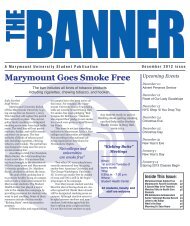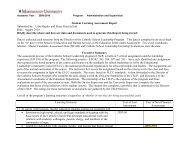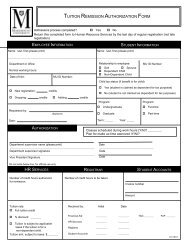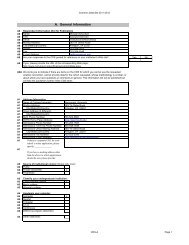STUDENT LEARNING ASSESSMENT PLAN - Marymount University
STUDENT LEARNING ASSESSMENT PLAN - Marymount University
STUDENT LEARNING ASSESSMENT PLAN - Marymount University
Create successful ePaper yourself
Turn your PDF publications into a flip-book with our unique Google optimized e-Paper software.
Academic Year : 2008/2009 Program: Interior Design Undergraduate<br />
Learning outcome 4: There are currently no set up for assessment for this outcome in place. The academic year 2009/2010<br />
evaluation tools are being put into to place to assess this outcome.<br />
Learning outcome 5: Internship Employer Evaluations. Interior design students complete internships for a total of 6 credit hours.<br />
Employer evaluations meet the needs of interior standards for interior design minimum proficiency as defined by both NCIDQ<br />
(National Council for Interior Design Qualification) and CIDA (Council for Interior Design Accreditation) practice analysis assessment<br />
and have been created as an assessment tool for student’s application of knowledge and skills in workplace environment. MU interior<br />
design student’s internships are conducted at commercial firms, architectural firms, residential firms, retail firms and showrooms.<br />
(See Attachment : ID 400 Employer Evaluation)<br />
The employer evaluations only give a small “snap shot” of what the students are learning in the area of contract administration and<br />
business practice. A more thorough assessment of this learning outcome would to be to concentrate on the course ID 436: Business<br />
Practice and define some assessment tools to evaluate further these learning outcomes. Fall 2010, the mid-term and final exam will<br />
also be used as assessment tool for this learning outcome and additional learning outcomes identified in program review for CIDA<br />
accreditation..<br />
Learning Outcome 1: Students will capably use quantitative and qualitative skills to evaluate and assess project goals and<br />
objectives.<br />
Programmatic inquiry is the heart of design problem – thus, the programs main “inquiry outcome”. Programming is two pronged –<br />
discovery of information both qualitative and quantitative that is tested in the following stages: qualitative in the schematic stage and<br />
quantitative in the design development stage.<br />
This “inquiry outcome” in the future assessment 2011/2012 will be assessed in the following courses:<br />
ID 201: Studio I. Students are first introduced to the foundations of the design phases to evaluating design environments,<br />
human factors, end user needs and beginning ADA, universal and building, life safety codes.<br />
ID 303: Studio 4. Students deal with a larger, more complex project in this studio classroom. Incorporated are more variables<br />
of end users within the space and components of human factors where ADA , universal, and building, life safety codes.<br />
3
















